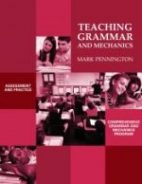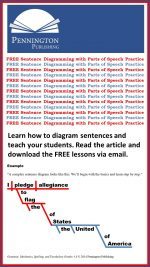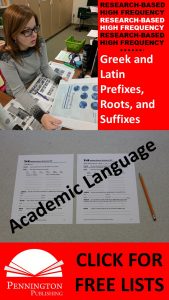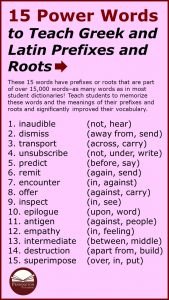English teachers learn early in their careers that strong nouns and “show-me” verbs are the keys to good writing. Of these two keys, verbs give developing writers the most “bang for their buck” in terms of writing revision. As a plus, revising weak and imprecise verbs, such as helping verbs (also known as auxiliary verbs), with active “show-me verbs” is quite teachable and less vocabulary-dependent than working with nouns.
“Now wait a minute (I can hear some of you thinking). Some writing necessitates using helping verbs to precisely communicate.” Quite true. Helping verbs can be useful to the writer. There… I just used two (“can be”). Feel any better? However, in most instances helping verbs tend to weaken writing, so students who master strategies to eliminate these “writing crutches” learn to write with greater precision and purpose. This article will help your students learn when to use helping verbs. Students will also learn when not to use them and how not to use them.
When to Use Helping Verbs
1. Use these helping verbs: will and shall* before the base form of the verb to indicate the future tense. The future verb tense is used for an action or state of being that will definitely (according to plan) take place in the future. For the future verb tense, add a helping verb in front of the base verb form.
Example: Mr. Thomas will go to the meeting tomorrow.
* In American English, the helping verb shall is becoming archaic. Originally, shall was used for first person pronouns and will for second and third person pronouns. Example: I shall go, but you and he will remain. Additionally, shall implies a necessity, while will indicates an intention.
The helping verb will can been combined with has or have + the present participle (a verb ending in d, ed, or en for regular verbs) to form the future perfect verb tense in which the verb form refers to a physical or mental action or a state of being that will be completed before a specific time in the future.
Example: We will have walked six miles by three-o’clock this afternoon.
2. Use these helping verbs: is, am, are, was, were, be, being, and been (the “to-be-verbs”*) when the progressive form of the verb is necessary.
-The past progressive describes an action that took place over a period of time in the past.
Example: Amanda was entertaining her guests when her grandmother arrived.
-The present progressive describes an ongoing action happening or existing now.
Example: She is walking faster than her friend.
-The future progressive describes an ongoing action that will take place over a period of time in the future.
Example: Amanda will be taking reservations over the holidays.
* The “to-be” verbs can also serve as linking verbs in predicate adjectives such as in “She is nice” and in predicate nominatives such as in “I am he.” See How to Eliminate “To-Be” Verbs for helping teaching strategies.
3. Use these helping verbs: may, might, must, ought to, used to, need to, should, can, could, and would (the “modals”) before the main verb to modify that verb by in order to communicate respect, politeness, permission, possibility, necessity, a command, or state an opinion.
Example: I should know better by now, but I just might ask her anyway.
4. Use these helping verbs: do, does, and did to form negatives with the main verb.
Example: I said do not go in there alone.
-Also use do, does, and did to form interrogatives. Notice how these helping verbs can be separated from the main verb when used in questions.
Example: Did you go in there alone?
-Also use do, does, and did to show emphasis.
Examples: Did you break that? Do visit your grandmother.
-Also use do, does, and did to avoid repeating verbs.
Example: I enjoyed our visit and so did he.
5. Use these helping verbs: has, have, and had to form the perfect verb tenses.
-The past perfect verb tense refers to a physical or mental action or a state of being that was completed before a specific time in the past. The past perfect is formed with had + the past participle (a verb ending in d, ed, or en for regular verbs).
Example: Cecil and Rae had finished their study by the time that the teacher passed out the test study guide.
-Another form of the past perfect verb tense is the past perfect progressive. The past perfect progressive describes a past action that was interrupted by another past event. It is formed with had been and the _ing form of the verb.
Example: My dad had been driving for two hours in the snowstorm when the Highway Patrol put up the “Chains Required” sign.
-The present perfect verb tense refers to a physical or mental action or a state of being happening or existing before the present. The present perfect is formed with has or have + the past participle (a verb ending in d, ed, or en for regular verbs).
Example: He has already started his science project.
-Another form of the present perfect verb tense is the present perfect progressive. The present perfect progressive describes the length of time an action has been in progress up to the present time. It is formed with have been and the _ing form of the verb.
Example: The students have been writing for over an hour.
-The future perfect verb tense refers to a physical or mental action or a state of being that will be completed before a specific time in the future. The future perfect is formed with a helping verb such as the modals: can, could, may, might, must, shall, should, will, and would + has or have + the present participle (a verb ending in d, ed, or en for regular verbs).
Example: We will have walked six miles by three-o’clock this afternoon.
-Another form of the future perfect verb tense is the future perfect progressive. The future perfect progressive describes the length of time an action will be in progress up to a specific time in the future. It is formed with will have been and the _ing form of the verb.
Example: The students will have been playing the same video game for two hours by the time their friends arrive.
When Not to Use Helping Verbs
1. Don’t use helping verbs when an ongoing action is not meant. An ongoing action is the progressive form of the verb.
Example: Don’t say “I am watching cartoons every day.” “I watch cartoons every day” is correct.
2. Don’t use helping verbs when an action does not indicate some event that takes place before another action. An action that indicates that some event takes place before another action is the function of the perfect tense.
Example: Don’t say “I have watched the five cartoon shows today.” “I watched five cartoon shows today” is correct.
3. Don’t use helping verbs when the passive voice is not necessary.
Example: Don’t say “Canned foods were collected by me to feed the hungry.” “I collected canned foods to feed the hungry” is correct.
4. Don’t use helping verbs when a more specific verb form can make an action less vague.
Example: Don’t say “That point guard is good.” “That point guard dribbles, passes, and shoots well” is more specific.
5. Don’t use an unnecessary helping verb when an active, “show-me” verb will communicate the same thought in a more concise manner.
Example: Don’t say “John never does clean the house.” “John never cleans the house” is better.
Problem-Solving Strategies to Eliminate Helping Verbs
1. Substitute-Sometimes the writer can think of a stronger verb to directly replace a helping verb. For example, instead of “That apple pie sure is good,” substitute the “to-be” verb is with tastes as in “That apple pie sure tastes good.”
2. Rearrange-Start the sentence differently to see if this helps eliminate helping verbs. For example, instead of “I could see the monster was creeping down the dark tunnel,” rearrange as “Down the dark tunnel I saw the monster creep.”
3. Change another word in the sentence into a verb-For example, instead of “Charles Schulz was the creator of the Peanuts cartoon strip and did serve as its illustrator,” change the common noun creator to the verb created and illustrator to illustrated as in “Charles Schulz created and illustrated the Peanuts cartoon strip.”
4. Combine sentences-Look at the sentences before and after the one with the “to-be” verb to see if one of them can combine with the “to-be” verb sentence and so eliminate the “to-be” verb. For example, instead of “You should complete your math homework. You must have studied for the math test. Then you can go outside to play,” a writer could revise as “Complete your math homework, study for the math test, and then go outside to play.”
A Teaching Plan to Eliminate the Helping Verbs
1. Post a list of the helping verbs and the problem-solving strategies/examples listed above for student reference.
2. Share and practice the strategies one at a time.
3. Use teacher think-alouds to model the revision process, using the selected strategy on student writing samples. Demonstrate flexible problem-solving and don’t be afraid to show how you can’t always think of a solution to revise helping verbs.
4. Next, turn the revision chore on over to the whole class with student writing samples. Ask students to volunteer their revision solutions.
5. Then, require students to revise student writing samples with helping verb individually. Correct whole class and praise the variety of effective revisions.
6. Next, have students revise their own sentences from their own writing samples.
Teaching the strategies to eliminate unnecessary helping verbs and practicing them in the context of student writing samples will help students recognize and avoid these “crutches” in their own writing. The results of your instruction? More precise and purposeful student writing with active, “show me” verbs.
*****

Teaching Grammar and Mechanics Grades 4, 5, 6, 7, 8, and High School Programs
I’m Mark Pennington, author of the full-year interactive grammar notebooks, grammar literacy centers, and the traditional grade-level 4, 5, 6, 7, 8 and high school Teaching Grammar and Mechanics programs. Teaching Grammar and Mechanics includes 56 (64 for high school) interactive language conventions lessons, designed for twice-per-week direct instruction in the grade-level grammar, usage, and mechanics standards. The scripted lessons (perfect for the grammatically-challenged teacher) are formatted for classroom display. Standards review, definitions and examples, practice and error analysis, simple sentence diagrams, mentor texts with writing applications, and formative assessments are woven into every 25-minute lesson. The program also includes the Diagnostic Grammar, Usage, and Mechanics Assessments with corresponding worksheets to help students catch up, while they keep up with grade-level, standards-aligned instruction.

Grammar, Mechanics, Spelling, and Vocabulary Grades 4, 5, 6, 7, 8 Programs
Or why not get the value-priced Grammar, Mechanics, Spelling, and Vocabulary (Teaching the Language Strand) grades 4, 5, 6, 7, and 8 BUNDLES? These grade-level programs include both teacher’s guide and student workbooks and are designed to help you teach all the Common Core Anchor Standards for Language. In addition to the Teaching Grammar and Mechanics program, each BUNDLE provides weekly spelling pattern tests and accompanying spelling sort worksheets (L.2), 56 language application opener worksheets (L.3), and 56 vocabulary worksheets with multiple-meaning words, Greek and Latin word parts, figures of speech, word relationships with context clue practice, connotations, and four square academic language practice (L.4, 5, and 6). Comprehensive biweekly unit tests measure recognition, understanding, and application of the grammar, mechanics, and vocabulary components.
The program also has the resources to meet the needs of diverse learners. Diagnostic grammar, usage, mechanics, and spelling assessments provide the data to enable teachers to individualize instruction with targeted worksheets. Each remedial worksheet (over 200 per program) includes independent practice and a brief formative assessment.
Check out the brief introductory video and enter DISCOUNT CODE 3716 at check-out for 10% off this value-priced program. We do sell print versions of the teacher’s guide and student workbooks. Contact mark@penningtonpublishing.com for pricing. Read what teachers are saying about this comprehensive program:
The most comprehensive and easy to teach grammar, mechanics, spelling, and vocabulary program. I’m teaching all of the grade-level standards and remediating previous grade-level standards. The no-prep and minimal correction design of this program really respects a teacher’s time. At last, I’m teaching an integrated program–not a hodge-podge collection of DOL grammar, spelling and vocabulary lists, and assorted worksheets. I see measurable progress with both my grade-level and intervention students. BTW… I love the scripted lessons!
─Julie Villenueve
Get the “To Be” Verbs Posters FREE Resource:

Grammar/Mechanics, Literacy Centers, Spelling/Vocabulary, Study Skills, Writing
English grammar, English verbs, essay, essay strategies, helping verb worksheets, helping verbs, how to teach helping verbs, how to teach linking verbs, how to teach verbs, linking verb worksheets, linking verbs, Mark Pennington, parts of speech, perfect tense, predicate adjectives, predicate nominatives, progressive verb forms, revision techniques, to be verbs, transitive verbs, verb worksheets, writing revisions

![]()
![]()


















